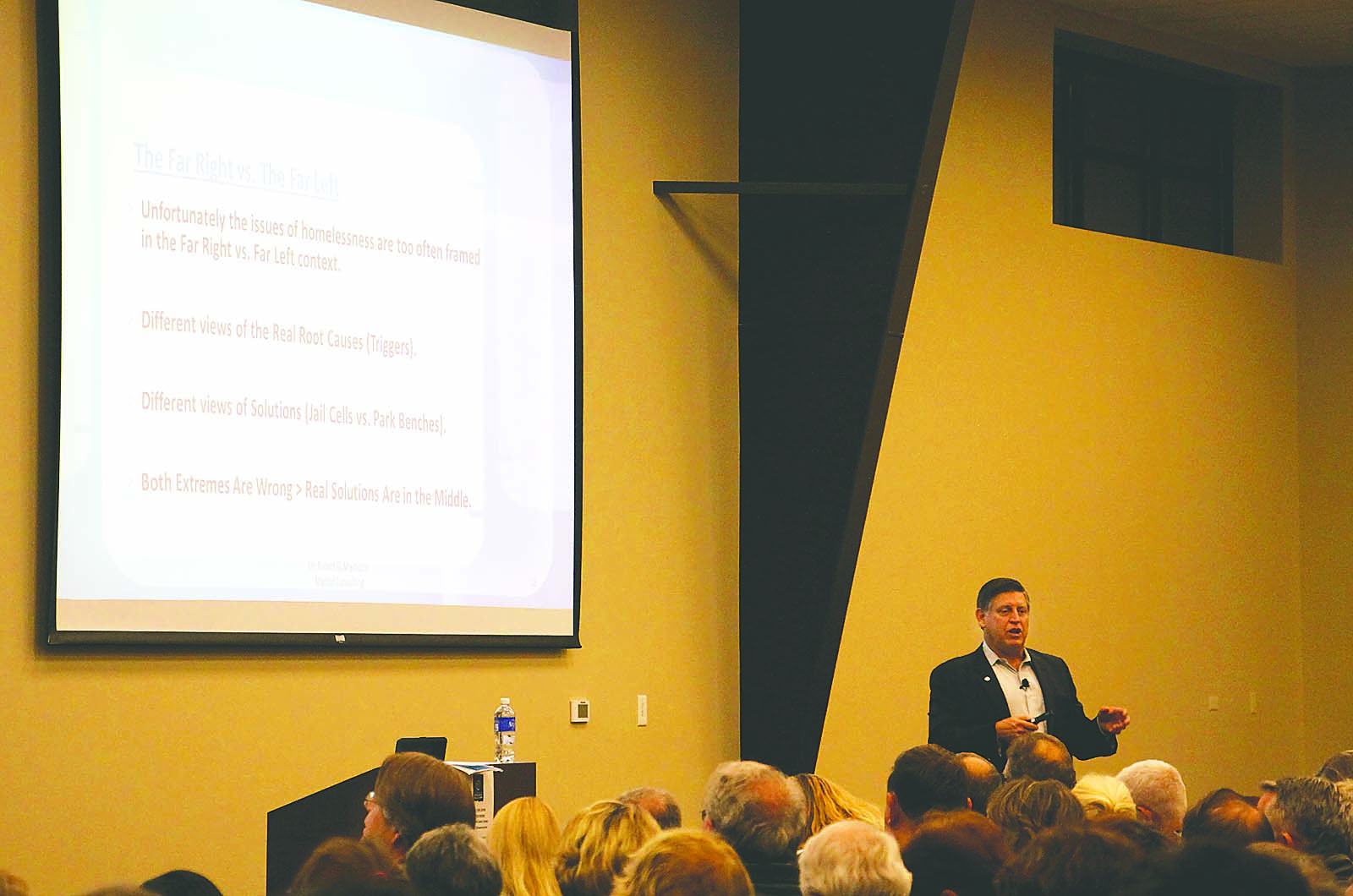If the attendance at the Oct. 27 Summit on Homelessness is any indication of a commitment to work on that issue, Lebanon is off to a good start.
Now a smaller coalition of city officials and others interested in homelessness are meeting to work on solutions.

Minutes before the summit was scheduled to begin, Boulder Falls Event Center staff had to roll out additional chairs to accommodate the approximately 300 people who showed up.
Addressing the issue of homelessness is one of the priorities that came out of Lebanon’s 2040 Vision process, said Gary Marks, city manager.
“It became clear that as a community we wanted to do better and make a real difference in the persistent condition of homelessness in Lebanon,” he said. “So here we are this evening. Tonight is only the beginning of new efforts in the area of homelessness and it is my hope that in time, as we become more knowledgeable about homelessness in Lebanon, we might find ways to address the myriad of issues this subject brings to our town.”
Dr. Robert G. Marbut, a Texas-based consultant on homelessness, spoke at the summit.
Marbut shared his observations after interviewing people who are homeless in Lebanon, as well as representatives from the agencies and churches who help them.
Homelessness in Lebanon is a home-grown problem, he said.
A little more than half of the homeless people Marbut interviewed, said they either went to Lebanon High School or another Linn County school.
He initially thought people were coming to Lebanon from Portland, he said.
“The people becoming homeless are our fellow brothers and sisters from right here,” Marbut said. “They’re not coming in from another place.”
In a conversation after the summit, Marks said when he started as city manager in 2014, he thought the homeless population was about 25.
“Dr. Marbut identified more than double that number,” Marks said. “I was also interested to learn that
the population is largely “home-grown” as opposed to transplants from other places.”
The most common place the other half of Lebanon’s homeless population comes from is Sweet Home, then Albany, Marbut said.
One of the federal government’s definitions of a chronically homeless person, is someone who has been homeless for one year or more.
“You’re well beyond the mark,” Marbut said. “In most cities, the mark is under one year.”
The good news is that Lebanon’s problem is not getting bigger, he said.
The bad news is, Lebanon’s current collective efforts are making the problem worse, according to Marbut.
“The system of things you’re doing is making a person, instead of being homeless less than one year, you have an average of three years,” he said. “What you’re doing now is not working. I’ll just be blunt. That’s why all of your numbers are on the high end. What you’re doing needs to change if you want to change it.”
Marbut stressed treating the root causes of homelessness.
He said about half of the people who are homeless have major mental health issues. That figure includes veterans suffering from Post Traumatic Stress Disorder. Seventy to 80 percent have substance abuse issues and about 90 percent have one or both of those issues, he said.
Loss of housing and lack of food are the symptoms, not the causes of homelessness, Marbut said.
As for mental illness and substance abuse, he said recovery does not happen on a jail cell floor.
Treatment plans should be customized to individuals he said. One way to help that happen is to have a master case management system. The different groups in a community that are working with individuals need to communicate and help with each individual’s circumstances.
Marbut found that veterans make up 20 percent of Lebanon’s homeless population.
“What’s sad about this is that the veterans are almost all post traumatic stress veterans,” Marbut said. “These are folks (who) volunteered to work for our country to do this on their own.”
The did not get care downrange or from veterans’ services, he said.
“They get handed off to VA and we’ve heard about all those problems,” Marbut said.
About 25 percent of downrange personnel are women, he added.
“We have women who get all the post traumatic the guys get, plus they get an equivalent of domestic violence because of sexual assault going on downrange by our own people, not by someone else,” Marbut said.
Marbut’s presentation was a well-laid-out representation of street-level homelessness in Lebanon, said Jennifer Morris after the event.
Morris is the development director for the Center Against Rape and Domestic Violence.
She agrees with Marbut’s point about addressing the root causes of homelessness.
“At CARDV we are able to help prevent homelessness to individuals and families who call our crisis and response support line by offering our shelter and other supportive resources,” Morris said. “Domestic violence is one of the most common factors why women are homeless. Women who are homeless are a vulnerable population who are at a high risk of experiencing domestic violence and sexual assault.”
Marbut said cities are going to see more female veterans with PTSD combined with domestic abuse trauma. There is money to help veterans, though.
“We have already been internally talking about how we go about doing this,” Marbut said.
In most parts of the country, VASH vouchers are not being used, he said.
According to the U.S. Department of Human Services website, the “HUD-Veterans Affairs Supportive Housing (HUD-VASH) program combines Housing Choice Voucher (HCV) rental assistance for homeless Veterans with case management and clinical services provided by the Department of Veterans Affairs.”
The Lebanon Police Department is going to lead a new outreach team, Marbut said.
Marks said a group of citizens came up with the goal before they’d heard Marbut’s recommendations.
“They said we need to form a coalition and on that coalition we need to have representatives from several of our churches, our nonprofits and government agencies and better coordinate,” he said.
That coalition is chaired by Dave Albanese, community service officer.
As of Nov. 15, the coalition had met twice, Albanese said. They plan to meet weekly through the first of next year.
Other members of the coalition are Tanya Thompson, of Linn County Mental Health Service; Dina Eldridge, of Community Services Consortium; Kyle Randleman, of PNW Adult & Teen Challenge; Kimberly Bevel, of Pay it Forward; Roseanne Hartness, of the Lebanon Community School District; Sean Casey, of the Lebanon Soup Kitchen; and Scott Eberhart, of Transform Lebanon/Lebanon Ministerial Association.
“We also have extended an invitation to Samaritan Hospital to have a representative,” Albanese said.




